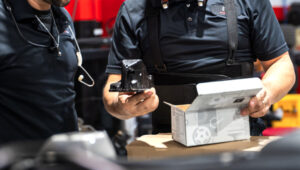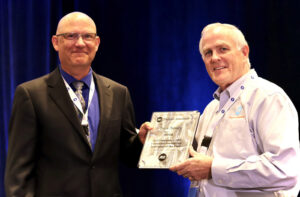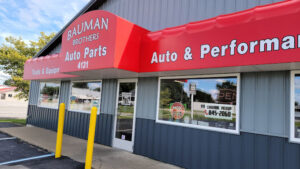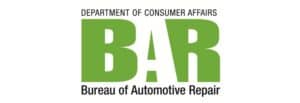This list is a collection from some of the most successful auto repair shop owners in California. Use this document to help you create your plan.
Editor’s Note: The following is reprinted with permission from the Automotive Service Councils of California. ASCCA notes that this list is not all-inclusive, especially to your local area. You must contact your city and county to make sure you comply. ASCCA takes no responsibility or liability for any licenses and permits that may be required and not listed. To learn more about ASCCA or to become a member, click here.

Sacramento, Calif.—This list is a collection of the wisdom of the smartest, most successful auto repair shop owners in California. Take it from all of us, you’ll enjoy the business more and have less worry if you develop a plan and follow a guide. Use this document to help you create your plan. It’s not meant to be legal, tax, or accounting advice. You should seek that expertise by contacting a licensed professional who can assess your specific situation and offer recommendations.
BASIC 10 STEPS
1. Put together an auto repair shop business plan that lists:
a. What services will you offer: what is your unique selling proposition; if you offer a warranty, what is it. All this information will be the foundation for your marketing efforts.
b. Where will you be located? Be sure to check with the city’s local planning department to be sure you can have an ARD in that specific location Many cities within California have restrictions on locations for shops in their zoning laws–check the zoning laws before you move forward with your location and BEFORE YOU SIGN A LEASE.
c. Are you building a business from scratch or are you taking over an existing one?
d. Source of your funding?
e. Who are your competitors?
f. Who are your target customers–they will help define your marketing plan? Target vehicles and types of jobs. Do you want to do general repair or manufacturer specific?
2. Form a legal entity: LLC, corporation, sole proprietor, partnership, and register your company in the State of California. Talk with a CPA that you trust to establish what would be the best one for you and your business model. The four most common legal entities are:
a. Sole proprietorship: This means that the business is owned and run by one person with no legal distinction between the owner and the business.
b. General partnership: A general partnership is the simplest variety of partnerships and is created automatically when two or more persons engage in a business enterprise for profit. No state filing is required.
c. Limited liability company (LLC): This is one of the most popular forms of business entity for small businesses. An LLC offers limited liability protection (shielding your personal assets by protecting them from debts and liabilities associated with the company) and pass-through taxation.
d. Corporation: A corporation is a separate legal entity owned by its shareholders, thereby protecting owners from personal liability for corporate debts and obligations.]
e. Register Your Company: All new businesses―except sole proprietorships―are required to register with the California Secretary of State. Expect to pay a modest filing fee when registering your company, which ranges between $30 and $150.
i. Note that when forming a corporation, LLC or LP in California, the registration forms you’ll file will vary depending on whether you’re a domestic vs. a foreign registrant. Domestic applicants reside in and plan to operate their business in the state of California. Foreign applicants intend to operate in the state of California but reside out-of-state or out-of-country.
3. Secure your financing: Finding the right loan for you may take some research on your part but is worth the effort. Make sure you have enough funding to pay the bills for at least 3 to 6 months while you are getting going.
a. Self-funding: Many entrepreneurs self-fund their startup ventures. This is a great option for businesses that require minimal start-up investments.
b. Family and friend loans: Make sure the terms of family and friend loans are clear before accepting funds from those closest to you.
c. Small business loans for startups: The best small business startup loans offer competitive rates and make it easy to access funds when you need them.
d. Small business grants in California: The advantage of a small business grant is that you don’t have to repay it.
e. Small Business Administration (SBA) microloans: The SBA offers SBA microloans up to $50,000.
4. Obtain required permits & licenses: check the separate list below of potential licensing and permitting requirements.
5. Open a business checking & saving account and credit card. First, you’ll need a fictitious business name: see the section below on licenses and permits for more information on how to file these forms.
6. Set up your business accounting; Consulting with/hiring a CPA that you trust should be an important first step to start out on the right foot. Having a payroll company can help you skip the pitfalls of payroll taxes if you are not knowledgeable in that area. Prepare to pay and collect taxes.
a. There are several agencies and programs that oversee tax collection and administration in the state of California. In addition, California businesses are also subject to federal taxation.
b. The California Tax Service Center offers a full breakdown of tax credits, deductions and taxable income. The California Department of Taxes and Fee Administration (CDTFA) offers further information on rates for 37 different kinds of taxes and fees. Because business tax rules and regulations can be complicated in California, it’s best to consult with an accountant to fully understand taxation regulations and requirements for your new business.
c. Minimum Franchise Tax: Most LLCs doing business in California are required to pay a minimum annual tax of $800, even if the LLC is not actively conducting business. That minimum tax continues until the LLC is officially dissolved with the state. However, for the tax years beginning January 2021 to January 2024, new LLCs are not subject to the annual $800 tax in their first year of operation. LLPs do not pay income tax but are subject to the annual franchise tax of $800. If the LLC earns more than $250,000, there is an additional annual fee due, depending on the amount of income.
d. Sales & Use Tax: Businesses operating in California that sell goods and services must collect appropriate taxes from customers based on the location the sale was made. The statewide tax rate is currently 7.25%. The CDTFA offers a breakdown of California sales and tax rates by county and city.
e. California State Payroll Taxes: All employers in the state of California must collect and pay payroll taxes. There are four types of state payroll taxes, two of which are paid by employers and two of which are withheld from employee’s wages:
1. Unemployment insurance: Paid from employer contributions, the maximum tax per employee each year is $434.
2. Employment training tax (ETT): Paid from employer contributions, the ETT rate is 0.1% up to a taxable wage limit of $7,000 per employee.
3. State disability insurance (SDI): Paid from employees’ wages, the SDI withholding rate for 2022 is 1.1% with a maximum withholding amount of $1,601.60.
4. Personal income tax (PIT): Paid from employees’ wages.
f. Tax Credits and Incentives for California Employers: If you plan to employ staff in your new business, be sure to explore tax incentives for California employers. You can reduce costs if you qualify for the following programs:
1. Work Opportunity Tax Credit (WOTC): Reduce your tax liability by up to $9,600 per new hire that qualifies for this credit.
2. Disabled Access Credit: Receive a credit of up to $5,000 if you qualify.
3. Architectural and Transportation Tax Deduction: Receive an annual tax deduction of up to $15,00 if you qualify.
7. Get your business insurance. There are different types of insurance you will need depending on the type of ownership you set up. See below for some of the common ones you will need.
8. Hire the right people.
9. Define & introduce your brand: read the separate section below on promoting your business.
10. Open for business! There’s nothing more exciting and unnerving than launching a business for the first time. The thrill of creating your own professional destiny and being your own boss — there’s nothing like it.

LICENSES, PERMITS AND MORE
Bureau of Automotive Repair (License Needs to be Posted): https://www.bar.ca.gov/licensing-ard
● Acquire needed specialized equipment for repairs with BAR regulations such as A/C repairs, transmission repairs, brake and lamp, smog repairs. See the BAR Write it Right handbook: https://www.bar.ca.gov/pdf/writeitright.pdf
City Business License (License Needs to be Posted):
● Basic business operation license: This is a license from the city in which your business will operate, or from the local county (if the business will be operated outside of the city’s legal boundaries)
Health Permit (License Needs to be Posted). Requirements vary by county and city, so contact your local enforcement agency for more information.
Choose a Registered Agent
● If you form an LLC, LP, LLP or corporation, you’ll need to assign an agent for service of process, also commonly called a registered agent, for your business. A registered agent is a person or company that receives legal and tax correspondence on behalf of your company. On average, you’ll pay between $50 to $300 a year for registered agent services.
● You can name yourself as a registered agent, but a professional registered agent service performs services that offer safeguards you won’t have if you act as your own agent. ○ For example, the best registered agent services receive essential documents on your behalf, alert you to pending filing deadlines and keep accurate records of which documents have been received. Failure to respond to legal notices could prove costly and perhaps even disastrous if critical deadlines are not met.
Determine if you need to File under the Corporate Transparency Act (CTA)
The Corporate Transparency Act (the “CTA”), which takes effect starting January 1, 2024, and imposes ownership disclosure requirements for LLCs, corporations, and other small business entities. Penalties for non-compliance are severe. The CTA will affect both new and existing businesses.
Reporting Companies can include U.S. LLCs, corporations, limited liability companies, and any other entities created by filing a document with a state’s Secretary of State, as well as any foreign company registered to do business in any U.S. state. FinCEN’s online Small Entity Compliance Guide includes a checklist for each of the 23 exemptions that may help determine whether a company qualifies for an exclusion. Business owners should carefully review the requirements for exclusion and speak with a professional before concluding that their company is excluded from the CTA. (https://www.fincen.gov/sites/default/files/shared/BOI_Small_Compliance_Guide_FINAL_Sept_508C.pd, see Chapter 1, “Does my company have to report its beneficial owners?”).
Additional information can be found on FinCEN’s website at https://www.fincen.gov/boi.
Get a Federal Employer Identification Number
● If you operate a sole proprietorship that hires employees, an LLC, corporation, or any type of partnership, you’ll need to obtain a federal employer identification number (federal EIN or FEIN) for your business entity. An EIN is a unique nine-digit number the IRS assigns to identify and track business entities in the United States that are subject to taxation. You’ll use Form SS-4 when applying for your EIN.
Fictitious Name Statement. Note: some cities require an appointment or form with the planning department to get a fictitious business name.
● You may already have a business name in mind or still be toying with a few ideas. The state of California offers a business name search portal where you can see if the name that you’re thinking about using is already registered with the state. For a processing fee of $10, you can reserve a business name for your corporation, LLC, or LP for up to 60 days through the California Secretary of State’s (CSOS) biz file website.
● Before settling on a name for your business, it’s wise to make sure that name is not already trademarked. Trademarking your new business name and registering a website domain for your business are smart ways to protect your investment in your new company.
● Finally, if your business will rely on social channels for promotion or client communication, be sure to investigate whether your business name―or suitable alternatives―are available before committing to a company name.
California Tax Dept of Tax and Fee Administration (Sales Tax): Sales tax license/sellers permit/resellers permit: This license/permit has many names and those names vary by state, but it is required for the selling of almost all products and services.
Check on Occupancy Permits, which could include:
Zoning and land use permits: Local governments’ zoning laws may prohibit certain business activity in designated areas.
Building permit: If you plan on remodeling or building a commercial space, you’ll need to get a building permit.
Insurance: Insurance policies that your auto repair business will need to obtain include: It will be important to find an insurance company or broker that you trust to help you find the right coverage.
● General liability insurance: This protects you from injury or accident claims, property damage, and false or misleading advertising.
● Commercial property insurance: Covers the costs of repair or the replacement of damaged assets.● ○ Commercial property insurance: Covers the costs of repair or the replacement of damaged assets.
● Workers’ compensation: Covers your business from medical expenses or lost wages in the event an employee is ill or injured.
● Employment Practices Liability Insurance is becoming more important as this covers job-related lawsuits that include (but are not limited to) wrongful termination, discrimination, workplace harassment, and retaliation.
● Garage insurance: Covers auto repair businesses from liabilities such as a customer injury or damages from faulty work.
● Umbrella policy: This gives you coverage above and beyond the limits you have on your other policies as added protection.
● ASCCA’s insurance provider partner is Armstrong and Associates and can provide all needed insurance for auto repair businesses.
Note: If you are leasing property, the lease agreement may require certain insurance limits.
Toxics, Hazardous Waste, & Related Agencies that may require Licensing and/or Permitting
● California EPA: You are required to apply for a CAL EPA number, and it must be on every work order you generate.
● Dept of Toxic Substance Control: You must register and report through The California Environmental Reporting Systems (CERS) https://cers.calepa.ca.gov/
● Dept of Industrial Relations, Division of Occupational Safety and Health Pressure Vessel Unit (Air Compressor Permit) (License Needs to be Posted)
● Possible County EPA and/or Environmental Health Permit (License Needs to be Posted)
● CA OSHA compliance items. Employee Manual Handbook, Illness and Injury Prevention Program, COVID policy manual, Heat Illness Prevention Program, Emergency Evacuation Plan, documented 2 years of Safety Training, Documented annual facility safety inspection, New Employee Safety Training, proper payroll policy for hourly employees. (Dave Fischer can provide all of the OSHA items to his clients)
● Get a good compliance coach.
Employees and HR Related Matters
● Possible Local Minimum Wage
● HR: Disciplinary Policy, Sexual Harassment Training. ASCCA partners Coremark Insurance and Dave Fischer can provide all of the needed HR items.
● Federal and California Employment Posters, Whistle Blower Policy, DEI Policy, more
● You will need to determine if you are required to provide health insurance and a retirement plan as well.
Other items that will need to be set up to get your business off to a smooth start:
● Join ASCCA. For more information or to join go to www.ascca.com.
● Set up:
○ Gas & electric
○ Phone service (if taking over a business make sure to keep the old phone number from the previous shop)
○ Alarm system
○ Trash & recycle services
○ Water
○ Internet
○ Cameras
○ Point of Sale system
○ Website & social media
○ Customer Relationship Management (CRM) Software
○ Uniform company. ASCCA partner Cintas is a good place to start.
○ Hazardous waste hauler
○ Scrap metal recycler
○ DMV/Lien sale company
○ NAPA Autocare, Technet, Bosch or other parts partners (there are lots of benefits to this type of arrangement)
○ IATN, Identifix, All Data, Mitchell and/or …
○ Accounts with local parts vendors and dealerships
○ Equipment repair and certification company
○ Fire extinguisher certification company
○ Join ASCCA: We put this on the list twice, because it’s so important for your new business!
Suggested professionals to seek as one builds (and maintains) their business:
● Business Operating System
● Human Resource (HR) professional
● Recruiter
● Commercial Insurance agent/broker
● Business Banker
● Certified Public Accountant (CPA)
● Bookkeeper
● Payroll company
● Benefits Broker
● Attorneys – Business, Estate, etc.
● Marketing Professional(s)
● Life insurance agent
● Financial planner
● Business Coach
Promote Your New Business
Implement a marketing strategy and define your core values as a shop. What are the three words your customers should think of when they think of your business? Honest, loyal, dependable? Print eye-catching flyers and put them in places where your customers will visit–gyms, coffee shops, local businesses.
● Create a USP list for your marketing efforts. A USP is a unique selling proposition: Answering this question is essential if you want a customer to choose your brand over others. Defining your USP will help you differentiate your shop, so you can stand out from your competitors. In short, you must explain what your company does best. See the section below for more info on creating a USP.
● Launch a website: Create a website that lists your services and is optimized for search engines. This will ensure your business ranks high when someone searches for a local repair shop. Use key search words and phrases in your body copy, headers, and metadata. Finally, be sure your website is designed with desktop and mobile users in mind. It also needs to be ADA compliant.
● Create a logo, brand culture, and style guidelines. Be sure your logo is throughout your business everywhere and anywhere a customer might be or see it–on your building, on your invoices, on your website and social channels, in your emails, in your advertisements, flyers, and other promotional materials.
● Get business cards. Yes, business cards–we know they seem so 1990’s, but you would be surprised how many times in this industry you will hand out a business card. Consider having business cards made for each one of your employees–doing that can go a long way toward developing that camaraderie among your employees that you are hoping for and help them to develop pride in the work they do and where they work.
● Launch a social media presence: Set up business pages and accounts on Facebook, Yelp, Google My Business, and Instagram. Regularly post updates, news, and specials. Consider paying for sponsored ads on Facebook and Google.
● Keep it legal with your emails. When emailing your customers be sure to follow all spam laws, including creating an unsubscribe list. Be sure your email footer has the proper unsubscribe language, your physical address and phone number, and how to reach you on social, make an appt., etc. TIP: consider segmenting your contact list so that your customers don’t unsubscribe from everything at one time, just that one type of email, i.e., monthly newsletters, promotions, customer education. And be sure to make it clear to your customers that they will always receive their invoices via email, if that is the policy in your shop, and that is not something they are able to unsubscribe from.
● Be consistent! Be sure to maintain a consistent message in your marketing materials. All of your materials should tie together and sound like the same “person” is writing all of them all the time.
● Get positive reviews: Online reviews can make or break a business. Think of ways to solicit reviews of your services from your customers. Companies like KUKUI and Broadly offer services to help collect reviews. Monitor reviews on social media and diplomatically respond to any unfair negative reviews.
● Network: Introduce your business to local businesses such as local towing companies and other firms that might want to partner with you. Join your local chamber of commerce and attend your local ASCCA Chapter Meetings, participate in the State ASCCA activities.
● Communicate value: Customers aren’t always looking for the cheapest service or repair, so be sure to develop a value proposition that differentiates your business from the next one. You can also build value through rewards programs, superior customer service, and an active online presence.
● Prioritize your customer experience. Find ways to go above and beyond to make the experience for your customer easy and convenient. ○ Train your service advisors and other customer-facing employees to put the customer experience first: always communicate in a friendly, professional, and courteous manner.
○ Offer value-adds such as pick up and drop off or a free Lyft ride.
○ Keep in touch with your customers through text-based service reminders, specials, news.
○ Make your waiting area as comfortable as possible. And make sure it’s CLEAN! Have good Wi-Fi service and current magazines for customers. Be sure to check the restrooms regularly and OFTEN for those that might be used by your customers.
○ Consider a customer loyalty program. You might offer your customers a free oil change after they come to see you for another service (like an engine repair or heating/air conditioning repair). A punch a deal card that gives a free service after 4 or 5 visits is a good retention tool as well. You can also send coupons in the mail to your neighbors.
○ Creating, using and promoting your customer referral program will bring in the types of customers that you are looking for. Don’t forget you need to “ASK” for the referral.
Creating a USP
In a crowded marketplace, it’s crucial to distinguish your brand from competitors. Effective marketing plays a pivotal role in achieving this differentiation. Defining your unique selling proposition (USP) is key to showcasing what sets your products or services apart and why customers should choose you over others.
What is a Unique Selling Proposition?
A unique selling proposition (USP) encapsulates in a concise statement what makes your business superior to competitors and why customers should opt for your offerings. It addresses their primary concerns and preferences.
Your USP could revolve around:
● Offering the lowest prices
● Delivering the highest quality
● Providing the fastest turnaround
● Having a distinct location
● Offering innovative products or services
● Providing unparalleled long-term warranty support
● Any other factor influencing customer buying behavior
Your USP serves as the foundation for your brand’s identity, slogans, product development, and customer interactions. It goes beyond mere marketing; it reflects your business values and growth strategy, with customer needs at its core.
How to Define Your Unique Selling Proposition
To create a compelling USP, consider the following steps:
1. Customer Focus:
Understand your customers’ needs, preferences, and purchasing behavior. Tailor your offerings to address their specific challenges and desires.
2. Alignment with Business Values:
Ground your USP in your company’s mission and values. Ensure that it reflects your commitment to fulfilling customer needs in a unique and meaningful way.
3. Highlight Strengths:
Identify your business’s strengths by evaluating what you excel at. Frame these strengths in terms of how they solve customers’ problems or fulfill their desires.
4. Contrast with Competitors:
Differentiate yourself from competitors by emphasizing how your offerings outperform theirs. Highlight areas where you excel and fulfill niche demands that competitors may overlook.
Examples of Unique Selling Propositions
Gongshow Gear:
By capturing the essence of hockey culture both on and off the ice, Gongshow Gear positions itself as the premier lifestyle brand for hockey enthusiasts, offering apparel and accessories tailored to their unique lifestyle.
AdvancedAG:
Through over two decades of research and proprietary technology, AdvancedAG sets itself apart by providing environmentally friendly soil enhancers designed to revolutionize agricultural practices, thereby promoting sustainable farming.
Communicating Your USP
Ensure consistency in communicating your USP across all customer touchpoints, both online and offline. Align your messaging with your brand values and maintain a cohesive brand identity to foster trust and loyalty.
Pitfalls to Avoid
● Neglecting customer needs in your USP
● Broadcasting inconsistent messages across channels
● Creating a superficial USP lacking in depth
● Partnering with entities conflicting with your brand values
Crafting a compelling USP requires thorough understanding of your customers, alignment with your business values, highlighting your strengths, and differentiation from competitors. By effectively communicating your USP, you can establish a strong brand identity and attract loyal customers.
Additional Resources
California State website for starting a business in California: https://www.sos.ca.gov/business-programs/business-entities/starting-business
California Bureau of Automotive Repair (BAR)
You must register with the Bureau of Automotive Repair (BAR) as an Automotive Repair Dealer (ARD) if your Dealership:
1. Performs repairs that require mechanical expertise.
2. Performs repairs to a part of the vehicle essential to its safe operation.
3. Receives compensation for any repair (including body repair work).
Some “minor” repairs are permitted without BAR registration including:
● Repairs made as part of a business agreement between a Dealer and a business.
● Repairing or replacing tires, lubricating vehicles, installing bulbs, batteries, wiper blades and minor accessories.
● Cleaning, adjusting, and replacing spark plugs, replacing fan belts, oil, and air filters.
● Other services customarily performed by gasoline service stations.
Valuable Reference Link: Business & Professions Code, Automotive Repair [9880-9880.3]
SCORE: Free general and specialty business startup help is available from your local Service Corps of Retired Executives office. Known as SCORE, this organization is a nonprofit volunteer organization which partners with the U.S. Small Business Administration.
CAL OSHA: Contact your local Occupational Health & Safety Administration and Environmental Protection Agency field offices to inquire about free business inspections and compliance information for auto repair shops. Compliance is the key to responsible business ownership and will keep you and your shop out of trouble should a workplace or environmental accident occur.
















Comments are closed.